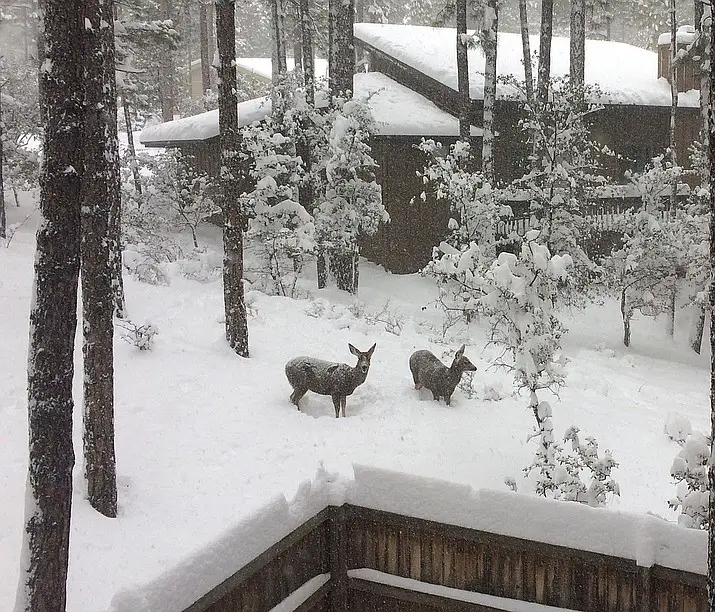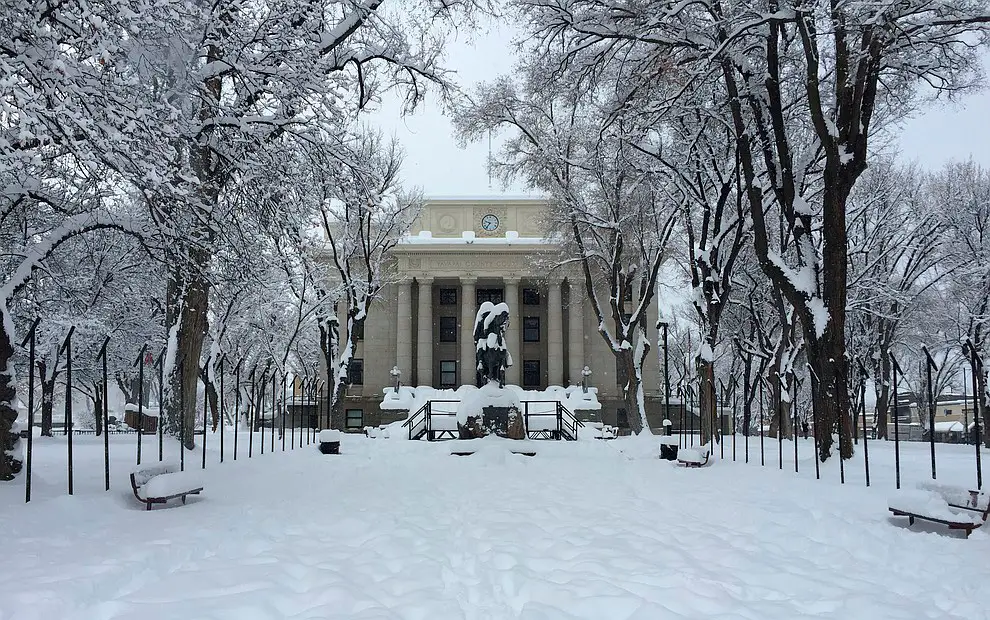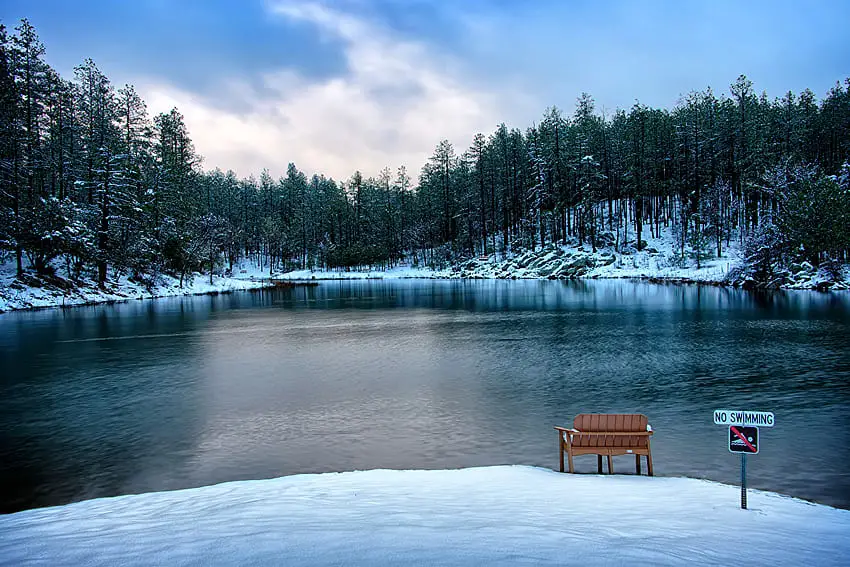Diverging from the typical arid image of Arizona, Prescott is a city that experiences all four seasons due to its elevation. Among these, winter, marked by the average snowfall in Prescott, AZ, is especially noteworthy. Prescott’s charming white winters are not only a delightful spectacle but also an intriguing climatic occurrence.

Prescott’s appeal extends beyond its historic architecture and vibrant culture to include a unique climate with moderate snowfall during winters. This climatic charm has made Prescott a favorite amongst both its residents and winter tourists. To understand why Prescott’s snowfalls are so special, we need to delve into the what, when, and how of it.
Living in Prescott means getting to experience a dash of winter chill as the city dons a snowy blanket. The snowfall, while captivating, is more than just a picturesque landscape. It’s an essential aspect of Prescott’s identity, influencing the lifestyle, the environment, and even the city’s appeal to tourists.
The Basics of Snowfall in Prescott
In meteorological terms, ‘average snowfall’ refers to the mean amount of snowfall an area receives over a period of time. For Prescott, this averages around 13 inches annually. Considering Arizona’s largely desert landscape, this statistic might be surprising, but Prescott’s altitude gifts it a cool, wet climate conducive to snowfall.
Prescott’s unique climate is a blend of Mediterranean and monsoon influences. The city experiences a warm, dry summer followed by a wet winter, a pattern that often results in a significant amount of winter snowfall. In fact, Weather Atlas reports that Prescott’s precipitation is highest in the winter months, further explaining the city’s unique snowfall phenomenon.
A Historical View of Snowfall in Prescott
Historical data from early 20th-century records up to the 1950s show relatively consistent snowfall patterns, offering a glimpse into Prescott’s historical winter landscapes. Over these decades, Prescott was a city that enjoyed white winters, becoming a part of its identity and charm.

Fast-forward to the 1950s, and the snowfall trends in Prescott start to show some fluctuations. However, the city continues to experience snowfall every year, retaining its winter wonderland reputation. While the intensity of snowfall varies, the occurrence of it has remained constant in Prescott’s winter season.
Month-by-Month Breakdown of Average Snowfall
A month-by-month examination of Prescott’s snowfall shows that December, January, and February are typically the snowiest months. With December ringing in the snowy season, January often sees the heaviest snowfall. February, while still snowy, usually marks the winding down of the snowfall season.
Interestingly, Prescott also experiences snowfall during the fringe months of November and March, although not as heavily as the peak winter months. This extended snowy season contributes to the annual snowfall total and provides residents and visitors with a longer window to enjoy the snow-draped cityscape.
Understanding Variability in Snowfall
The annual snowfall in Prescott shows substantial variation, a pattern influenced by several factors. Weather phenomena like El Niño and La Niña play a crucial role in affecting local weather patterns, leading to years of heavy snowfall or unusually dry winters.
Prescott has seen years of record snowfall, with US Climate Data reporting annual totals exceeding 24 inches. On the flip side, some years have recorded little to no snowfall. Understanding this variability is key to grasping the dynamic nature of Prescott’s winter season.
The Impact of Snowfall on Prescott’s Lifestyle
In Prescott, snow is more than just weather – it’s a cornerstone of local lifestyle and traditions. From snowball fights to more adventurous pursuits like snowshoeing, winter activities are woven into the fabric of Prescott’s community life. The annual Courthouse Lighting event, set against a snowy backdrop, is a testament to the town’s vibrant winter culture.

In addition to the recreational aspects, snowfall in Prescott also plays a practical role. Snowpacks, as they melt, slowly release water into the soil, acting as natural reservoirs that help replenish local water sources and maintain the region’s ecosystems.
Environmental Consequences of Snowfall Patterns
Snowfall impacts Prescott’s environment in numerous ways. As the snow melts, it gradually releases water into the soil, nourishing a variety of local plants including Prescott’s famed Ponderosa pines. This slow, sustained water release also supports the local wildlife, providing essential hydration during the arid summer months.
On a broader scale, snowfall feeds into Prescott’s water supply system. Meltwater from snow contributes to rivers and underground aquifers, playing a vital role in the city’s water security. This important function of snowfall underscores its environmental significance, as highlighted by Prescott Creeks.
Comparisons with Other Cities
When compared to Flagstaff, another high-altitude Arizona city, Prescott’s snowfall is less intense. Flagstaff, owing to its higher altitude, witnesses more severe winters with over 100 inches of average snowfall. Meanwhile, Phoenix, situated in Arizona’s desert region, sees little to no snowfall, demonstrating Arizona’s diverse climatic spectrum.
Such comparisons illuminate Prescott’s unique positioning, providing a touch of winter without the extreme conditions of higher-altitude regions or the snow-less winters of desert areas.
The Future of Snowfall in Prescott
As climate change becomes increasingly impactful, predicting future snowfall in Prescott becomes more complex. Some scientific models suggest that rising global temperatures could result in less snowfall, potentially altering Prescott’s winter landscape.
However, it’s important to note that these predictions carry a degree of uncertainty due to the complex interplay of climate variables.
Despite the uncertainty, it’s crucial for Prescott to prepare for a range of potential future climate scenarios. This includes adjustments at the city planning level and adaptations in the everyday lives of residents to maintain harmony with the changing climate.
How to Prepare for Prescott’s Snowfall
Preparation is key to comfortably navigating Prescott’s snowfall, whether you’re a resident or a visitor. For residents, this means staying updated with weather forecasts and getting their homes winter-ready. This could involve insulating your home, ensuring a steady supply of heating fuel, and prepping your car for winter driving.

Visitors should pack warm, layered clothing, and sturdy footwear, and be prepared for potential winter road conditions. These precautions will help ensure that your visit to Prescott is enjoyable, regardless of the weather. The city’s Office of Tourism also provides a wealth of information to help visitors prepare for their winter travels.
FAQ :
In this section, we will be delving into some of the most common inquiries and curiosities that surround our topic.
What is the average snowfall in Prescott, AZ?
Prescott receives an average of about 13 inches of snow annually.
Which months receive the most snowfall in Prescott?
The heaviest snowfall in Prescott typically occurs in December, January, and February.
How does Prescott’s snowfall compare to other Arizona cities?
Compared to Flagstaff, which receives over 100 inches of snowfall due to its higher altitude, Prescott’s snowfall is less severe. On the other hand, Phoenix, which is located in a desert region, sees very little to no snowfall.
How does snowfall affect Prescott’s environment?
Snowfall plays a significant role in maintaining Prescott’s environment. As the snow melts, it releases water into the soil, supporting local flora and fauna. Meltwater also feeds into rivers and underground aquifers, contributing to the city’s water supply.
How is climate change expected to impact snowfall in Prescott?
Predicting the exact impacts of climate change on Prescott’s snowfall is complex due to the interplay of numerous climate variables. However, some models suggest that rising global temperatures could lead to decreased snowfall in the future.
Conclusion
As we can see, the average snowfall in Prescott, AZ, is more than just a climatic occurrence. It’s a fundamental aspect of Prescott’s lifestyle, shaping the community’s traditions and even its environmental health.
While Prescott’s snowfall patterns may shift in response to climate change, the importance of understanding and adapting to these changes remains crucial. In a warming world, preserving Prescott’s unique winter charm will require both local effort and global cooperation.
Whether you’re a resident enjoying the annual snowy transformation of your city, or a visitor drawn by the prospect of an Arizonian winter wonderland, it’s undeniable that snowfall holds a unique appeal in Prescott.
With its soft white blanket, winter in Prescott is not just a season, but a celebration of the city’s vibrant life, rich history, and extraordinary natural beauty.



Leave a Comment
You must be logged in to post a comment.